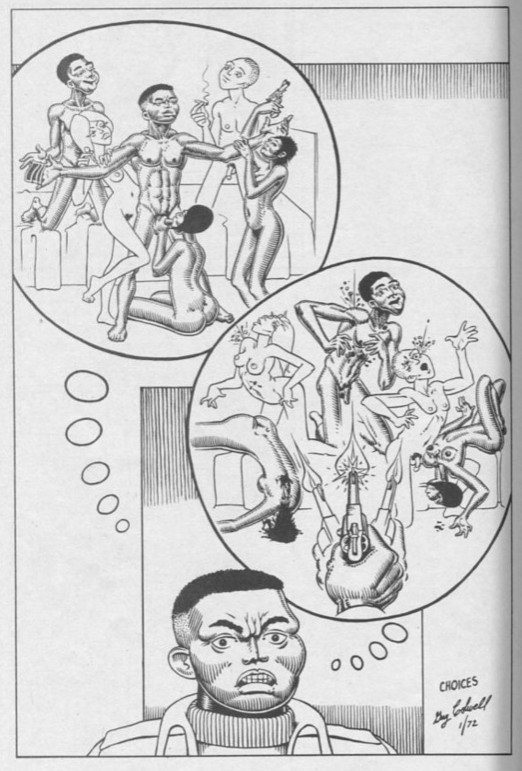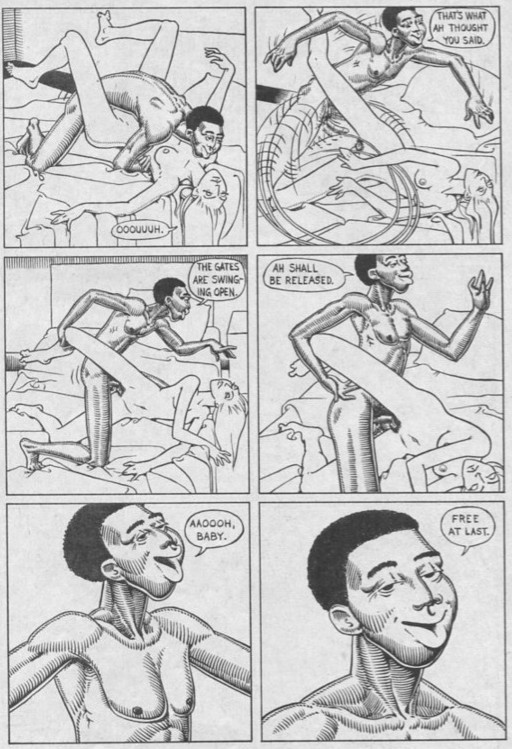The two images on this page come from “Choices” (1972), the first installment in Guy Colwell’s underground comic series Inner City Romance Comix. “Choices” tells the story of James and Marvin, two black men released from years in prison. James, bottom central to the first image, has discovered an emerging politicization in himself and a desire to elevate the state of his race in America. Marvin, who is prominent in the second image, has decided to celebrate his new freedom with sex, drugs, pimping and trafficking, the crimes for which he was originally sent to prison.
In this first image, James faces a choice: Should he settle into the hedonistic ways of his friend Marvin, or should he violently rebel against those ways and their lack of productivity? The representation of James’ struggle in this first image exemplifies the politics of underground comix and the black liberation struggle of 1970s America. In his essay “Icons of the Alternate Culture,” Clinton Sanders notes that “a common creative premise found in comix is the confrontation between the upstanding, white, middle-class, middle-aged citizen and the cultural or racial deviant” (841). This image subverts that common theme. While Marvin certainly represents the deviant or the “freak,” James can hardly be considered the antagonistic “straight” (Sanders 841). In contrast to Marvin, James certainly plays the role of the straight, fulfilling the “assumption.” Sanders observes that “the exotic hedonistic pleasures of the hip subculture exert a powerful pull on straights” (841). James’ face contorts almost in anguish, as the temptation of pleasure combats his desire for progress. However, his alternative is hardly straight, and nothing about James embodies the figure of “upstanding, white, middle-class, middle-aged citizen.”
Interestingly, while Marvin’s temptation does beckon to James, “Choices” resists the common trope of the deviant’s victory (Sanders 841). If James chooses the violent choice, then Marvin dies with a look of bemused shock on his face, perhaps a nod to the advantage his role usually has in the medium. However if James chooses to surrender to pleasure, sex and drugs, then he still emerges victorious. This victory is evident in the first image where James stands at the center of the orgy in a Christ-like pose as women, black and white, marvel at his manhood and his male friends look on with pleasure, support and respect.
Sanders argues that this type of Christian imagery is another common element of underground comix (845). In this particular image, the parodic invocation of Christ delineates the stark differences between the choices James faces and at the same time critiques both choices. By choosing pleasure, James sacrifices himself as an agent of change, but the crimes that society has inflicted on him absolve him of the sin. And by choosing violence, James agitates toward the difference he wants to make, becoming a militant civil rights crusader, but also undermines the morals that undergird his humanity. Through blasphemous parody, James’s imposition into the Christ pose emphasizes that despite the contrasts between him and Marvin, he was never the “straight.” This idea encapsulates what Sanders describes as a tendency of underground comix to “provide the vacillating straight with a new way to look at reality and a repertoire of alternate behavioral models” (848-9). Whichever way James may choose, his decision and the disgust that fuels it lie within the realm of counter-culture, and through this choice Colwell is able to underscore the place of underground comix and yet at the same time criticize the counter-culture in which they reside.
This second image demonstrates Colwell’s politicization of sex through his depictions of race and gender and his use of religious references. In his book Alternative Comics: An Emerging Literature, Charles Hatfield writes that the underground comix movement “was sparked by the political energy of the late sixties counterculture, and reflected its demands for peace and political reform” (Hatfield 18). The presence of interracial sex in the comic captures the countercultural revolts against the mainstream. Colwell emphasizes the interraciality of the sex between Marvin and his white partner through the visual contrast between their bodies; simple hatching creates the color of Marvin’s skin while his partner is left completely uncolored.
Colwell’s representation of gender in the image is also highly political. The artistic choices involved in the creation of both characters speak to Marvin’s dominance as a man. Colwell draws Marvin’s body with bulging muscles, a defined clavicle and thick black hair, and his facial expression with plump lips, a broad nose, and animated eyes. However the white woman in the panels is void of any detail except the contours of her hips and breasts. Marvin’s detailed features draw attention to not only his race and gender, but also to his personhood. Through lack of detail and expression on her face, Marvin’s sexual partner becomes just a white female body. Marvin’s actions in the panels also establish his superiority over the woman. When his partner moans with pleasure, Marvin asserts a masculine dominance as he turns her and then boasts about her pleasure.
The depictions of Marvin’s race and gender in the illustration are crucial in conjunction with the religious references in his dialogue. As he thrusts into the woman, he says, “The gates are swinging open. Ah shall be released.” This religious reference elevates his pleasure to some sort of holy territory. The panels then progressively zoom in to Marvin’s face, culminating in a close framing of his face looking directly at the viewer as he says, “Free at last.” His sexual release frees him, and he mockingly declares himself heroic by quoting the words of Reverend Martin Luther King Jr. This panel is both a climax and a punch line. It culminates Marvin’s sex scene, and also mocks the incongruity between Marvin’s non-progressive lifestyle and the freedom it grants him. According to Hatfield, irony is the stock and trade of the underground comic, and it is ironizing the form that “gave the comix books their unique edge” (8). In this panel, Marvin ironically alludes to Martin Luther King, in some ways a sacrilege to the politics Colwell espouses, but also a decided mockery of those politics. The humor of the moment, as well as its import, are rooted in irony, the fuel of underground comix and the politics of Colwell’s pornography in particular.
Sanders, Clinton R. "Icons of the Alternate Culture: The Themes and Functions of Underground Comix*." The Journal of Popular Culture 8.4 (1975): 836-852. doi: 10.1111/j.0022-3840.1975.00836.x
Hatfield, Charles. Alternative Comics: An Emerging Literature. Jackson, UP of Mississippi, 2005. Print.
Rosenkranz, Patrick. Preface. Inner City Romance. By Guy Colwell. Fantagraphics, 2015. vii – xv. Print.

